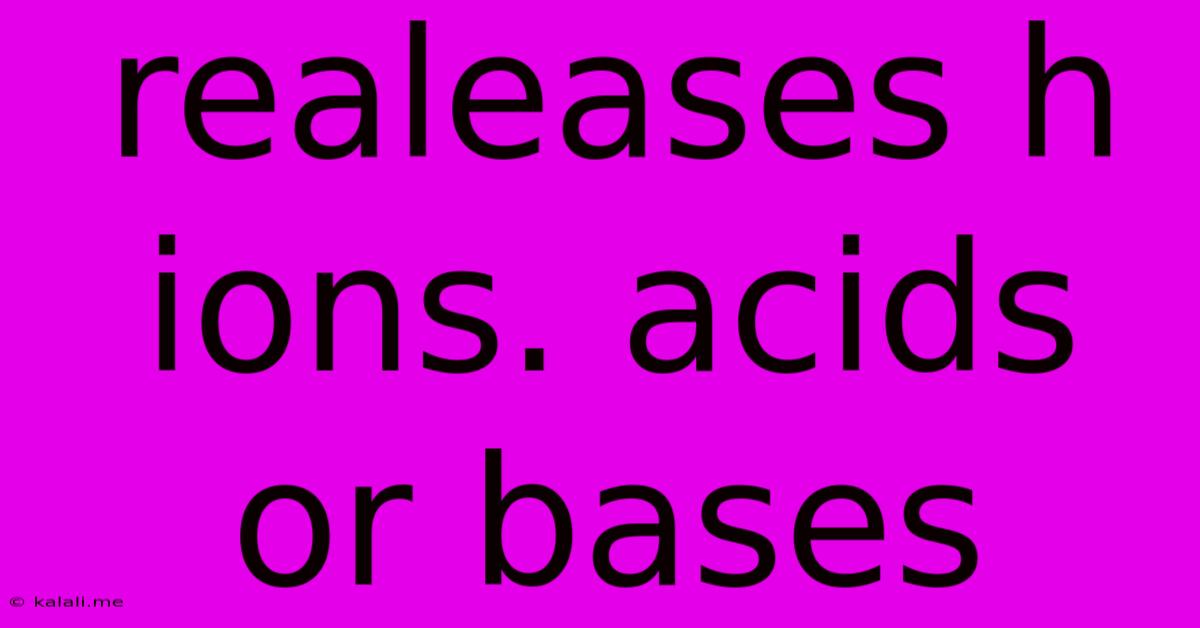Realeases H Ions. Acids Or Bases
Kalali
Jun 03, 2025 · 3 min read

Table of Contents
The Release of H⁺ Ions: Acids, Bases, and the pH Scale
This article explores the crucial role of hydrogen ions (H⁺) in defining acids and bases, explaining their release and the implications for the pH scale and everyday applications. Understanding H⁺ ion release is fundamental to chemistry and various aspects of our lives, from digestion to industrial processes.
What are Acids and Bases?
Acids and bases are two fundamental classes of chemical compounds defined by their behavior in solution. This behavior is primarily characterized by the release or acceptance of hydrogen ions (H⁺). The release of H⁺ ions is a key differentiator between acids and bases.
Acids: The H⁺ Ion Donors
Acids are substances that increase the concentration of H⁺ ions when dissolved in water. This happens because they donate or release protons (H⁺) into the solution. The stronger the acid, the more readily it releases H⁺ ions. Examples of common acids include:
- Hydrochloric acid (HCl): Found in stomach acid, essential for digestion.
- Sulfuric acid (H₂SO₄): Used extensively in industry for various applications.
- Acetic acid (CH₃COOH): The acid found in vinegar.
- Citric acid (C₆H₈O₇): Found in citrus fruits.
The release of H⁺ ions from an acid can be represented by a dissociation equation, for example:
HCl(aq) → H⁺(aq) + Cl⁻(aq)
This equation shows hydrochloric acid (HCl) dissociating in water to release a hydrogen ion (H⁺) and a chloride ion (Cl⁻).
Bases: The H⁺ Ion Acceptors
Bases, conversely, are substances that decrease the concentration of H⁺ ions in a solution. They achieve this by either accepting H⁺ ions directly or by releasing hydroxide ions (OH⁻), which then react with H⁺ ions to form water (H₂O). Examples include:
- Sodium hydroxide (NaOH): A strong base used in many industrial and cleaning applications.
- Potassium hydroxide (KOH): Another strong base with similar uses to NaOH.
- Ammonia (NH₃): A weak base found in many household cleaners.
- Calcium hydroxide (Ca(OH)₂): Used in making mortar and plaster.
The reaction of a base with H⁺ ions can be exemplified by the neutralization reaction between a strong acid and a strong base:
H⁺(aq) + OH⁻(aq) → H₂O(l)
The pH Scale: Measuring H⁺ Ion Concentration
The pH scale is a logarithmic scale used to measure the concentration of H⁺ ions in a solution. It ranges from 0 to 14, with:
- pH 0-7: Acidic solutions (higher H⁺ concentration)
- pH 7: Neutral solutions (equal H⁺ and OH⁻ concentration)
- pH 7-14: Basic or alkaline solutions (lower H⁺ concentration)
The pH scale is crucial for various applications, including:
- Monitoring water quality: Ensuring safe drinking water and protecting aquatic life.
- Agriculture: Maintaining optimal soil pH for plant growth.
- Medicine: Regulating the pH of bodily fluids for proper physiological function.
- Industry: Controlling pH in chemical processes to optimize reactions and product quality.
Strong vs. Weak Acids and Bases:
The degree to which an acid or base releases or accepts H⁺ ions determines its strength. Strong acids and bases completely dissociate in water, releasing all their H⁺ or OH⁻ ions. Weak acids and bases only partially dissociate, meaning they only release a small fraction of their H⁺ or OH⁻ ions.
Conclusion:
The release of H⁺ ions is the defining characteristic of acids and bases. Understanding this process, its relation to the pH scale, and the differences between strong and weak acids and bases is essential for grasping fundamental chemical concepts and their wide-ranging applications in science, technology, and everyday life. Further exploration into buffer solutions and titration techniques will provide a deeper understanding of H⁺ ion control and manipulation.
Latest Posts
Latest Posts
-
How To Eliminate Static Electricity From Body
Jun 05, 2025
-
Synonym For Benefit Of The Doubt
Jun 05, 2025
-
Bible Verse About Arguing With Fools
Jun 05, 2025
-
Is A Hot Dog A Sausage
Jun 05, 2025
-
What Type Of File Is Abcddb
Jun 05, 2025
Related Post
Thank you for visiting our website which covers about Realeases H Ions. Acids Or Bases . We hope the information provided has been useful to you. Feel free to contact us if you have any questions or need further assistance. See you next time and don't miss to bookmark.